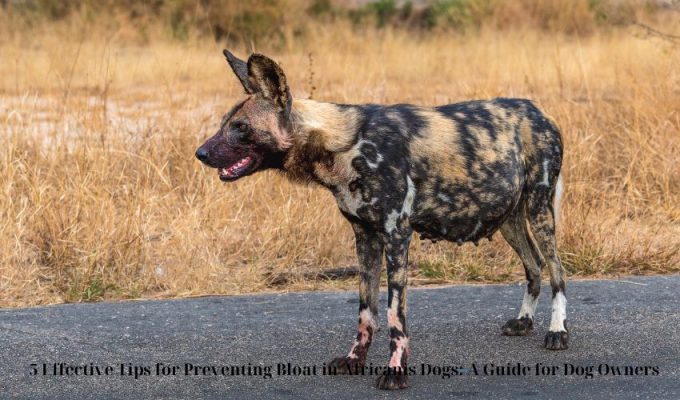Discover 5 effective tips for preventing bloat in Africanis dogs with our essential guide for dog owners.
Understanding Bloat in Africanis Dogs
Africanis dogs, like all other breeds, are susceptible to bloat, also known as Gastric Dilatation-Volvulus (GDV). This condition can be life-threatening if not treated promptly. It occurs when the dog’s stomach fills with gas, fluid, or food, causing it to expand and put pressure on other organs. In some cases, the stomach can twist on itself, leading to volvulus, which requires immediate medical attention.
Prevention Strategies
– Feed Small, Frequent Meals: Instead of giving your Africanis dog one or two large meals a day, opt for smaller, more frequent feedings to reduce the risk of bloat.
– Choose the Right Diet: Consult with your veterinarian to determine a diet that’s suitable for your Africanis dog’s age, size, and breed. Avoid foods with fats or oils listed as one of the first four ingredients.
– Use a Slow-Feeder Bowl: These bowls are designed to slow down eating, reducing the amount of air swallowed.
– Avoid Exercise Around Meal Times: Wait at least an hour before and after feeding before engaging your Africanis dog in vigorous exercise.
– Regular Health Monitoring: Regular check-ups with your veterinarian can help identify and manage conditions that may increase the risk of bloat.
It’s important for Africanis dog owners to be aware of the signs of bloat and seek immediate veterinary care if they suspect their dog is experiencing this condition. By implementing preventive measures and staying vigilant, pet owners can help reduce the risk of bloat in their Africanis dogs.

Tip 1: Proper Feeding Techniques
Feed Small, Frequent Meals
Feeding your dog smaller, more frequent meals can help reduce the risk of bloat. This feeding schedule reduces the amount of air swallowed and the pressure on the stomach, ultimately decreasing the likelihood of bloat.
Avoid Elevated Feeding
Contrary to popular belief, elevated food bowls can actually increase the risk of bloat, especially in large breeds. It is best to have your dog eat from a bowl placed on the ground to prevent the stomach from filling with excess air.
Choose the Right Diet
Consult with your veterinarian about a diet that’s appropriate for your dog’s age, size, and breed. Avoid foods that list fats or oils as one of the first four ingredients, as these can contribute to bloat.
Use a Slow-Feeder Bowl
Slow-feeder bowls are designed to make dogs eat more slowly, reducing the amount of air they swallow during meal times. This can be an effective way to prevent bloat in dogs.
Tip 2: Limiting Exercise Before and After Meals
Regular exercise is important for your dog’s overall health, but it’s best to limit vigorous activity around meal times. After your dog eats, their body needs time to digest the food properly. Engaging in vigorous exercise too soon after a meal can increase the risk of bloat. Similarly, it’s advisable to wait at least an hour before feeding your dog after a period of vigorous exercise.
Benefits of Limiting Exercise Before and After Meals
– Reduces the risk of the stomach twisting on itself (volvulus)
– Allows for proper digestion and absorption of nutrients
– Helps prevent excessive air swallowing during exercise
It’s important to strike a balance between allowing your dog to get enough exercise and ensuring they have adequate rest and digestion time around meal times. By incorporating this practice into your dog’s routine, you can further reduce the risk of bloat and promote their overall well-being.
Tip 3: Avoiding Stress and Anxiety
Stress and anxiety can contribute to the development of bloat in dogs. It’s important to create a calm and peaceful environment for your dog, especially during meal times. Avoid feeding your dog in a stressful or chaotic environment, and ensure that they have a quiet and comfortable space to eat. Additionally, providing your dog with regular exercise and mental stimulation can help reduce stress and anxiety, ultimately lowering the risk of bloat.
Ways to Reduce Stress and Anxiety:
– Establish a routine: Dogs thrive on routine and predictability. Establishing a consistent daily schedule for feeding, exercise, and playtime can help reduce stress and anxiety.
– Provide mental stimulation: Engage your dog in activities that stimulate their mind, such as puzzle toys, interactive games, or training sessions. Mental stimulation can help alleviate boredom and reduce anxiety.
– Create a safe space: Ensure that your dog has a designated, safe space where they can retreat to when feeling stressed or anxious. This could be a comfortable bed or crate in a quiet area of the house.
By implementing these strategies to reduce stress and anxiety, you can create a more relaxed and harmonious environment for your dog, ultimately contributing to their overall well-being and reducing the risk of bloat.
Tip 4: Monitoring Water Intake
Monitoring your dog’s water intake is crucial in preventing bloat. It’s important to allow your dog to drink small amounts of water before and after meals, but avoid letting them drink large volumes in one go. This can help prevent the stomach from filling too quickly and reduce the risk of bloat.
Benefits of Monitoring Water Intake
– Prevents excessive water consumption
– Reduces the risk of stomach filling too quickly
– Helps maintain proper hydration levels
By monitoring your dog’s water intake and ensuring they drink in moderation, you can contribute to their overall health and reduce the risk of bloat. Remember to consult with your veterinarian for personalized advice on your dog’s specific needs.
Tip 5: Consulting with a Veterinarian
It’s important to consult with a veterinarian for personalized advice on preventing bloat in dogs. A veterinarian can assess your dog’s specific risk factors, such as breed, age, and overall health, and provide tailored recommendations for diet, feeding practices, and lifestyle adjustments.
Benefits of Veterinary Consultation:
– Professional assessment of your dog’s individual risk factors for bloat
– Personalized recommendations for a suitable diet and feeding routine
– Guidance on managing any underlying health conditions that may increase the risk of bloat
– Access to expert advice on recognizing the early signs of bloat and seeking prompt veterinary care
Discussion with Veterinarian:
During your consultation, be prepared to discuss your dog’s current diet, feeding schedule, exercise routine, and any previous instances of digestive issues or bloat symptoms. Your veterinarian may also inquire about your dog’s overall behavior and stress levels to identify any potential triggers for bloat.
Remember, consulting with a veterinarian is an essential part of proactive bloat prevention and overall canine health management. Always follow the professional advice provided by your veterinarian to ensure the well-being of your furry companion.
In conclusion, preventing bloat in Africanis dogs is crucial for their health and well-being. By implementing proper feeding habits, avoiding strenuous exercise after meals, and monitoring their behavior, we can significantly reduce the risk of bloat in these beloved pets.






